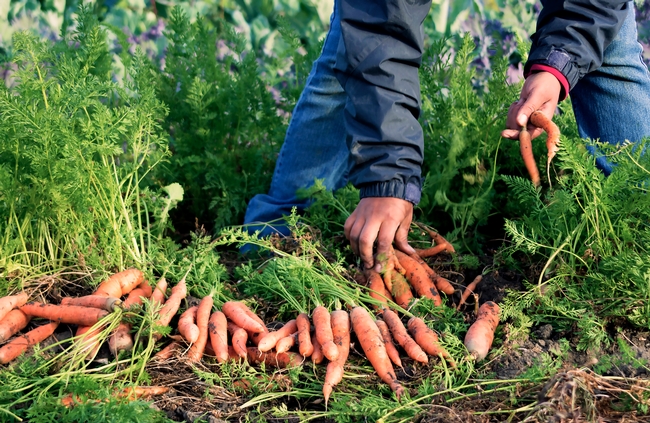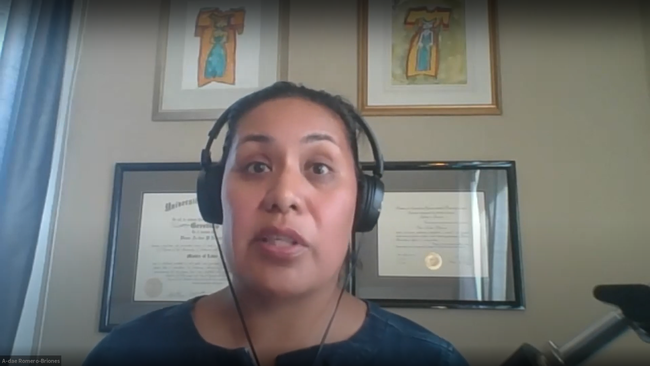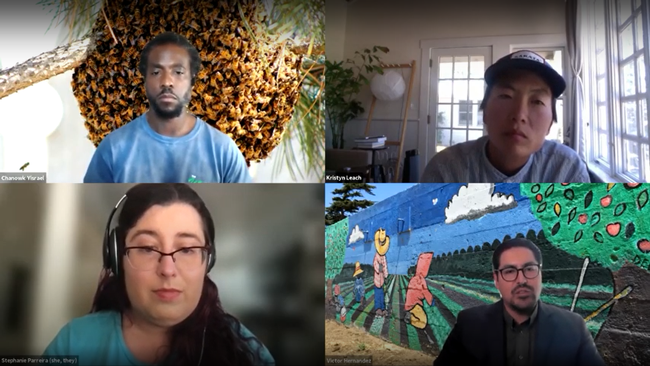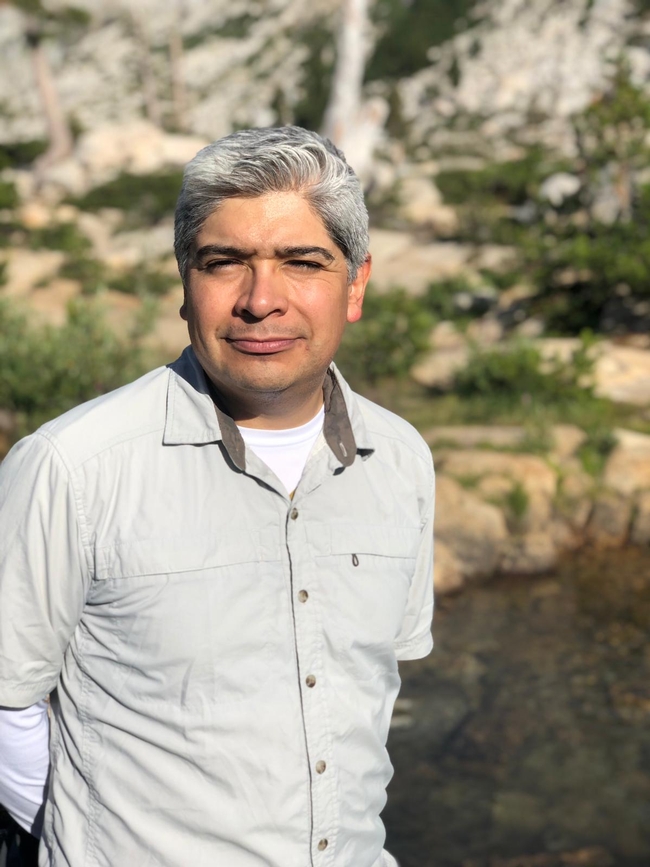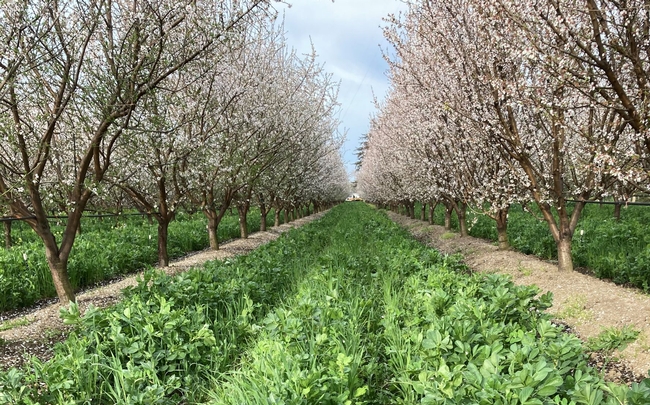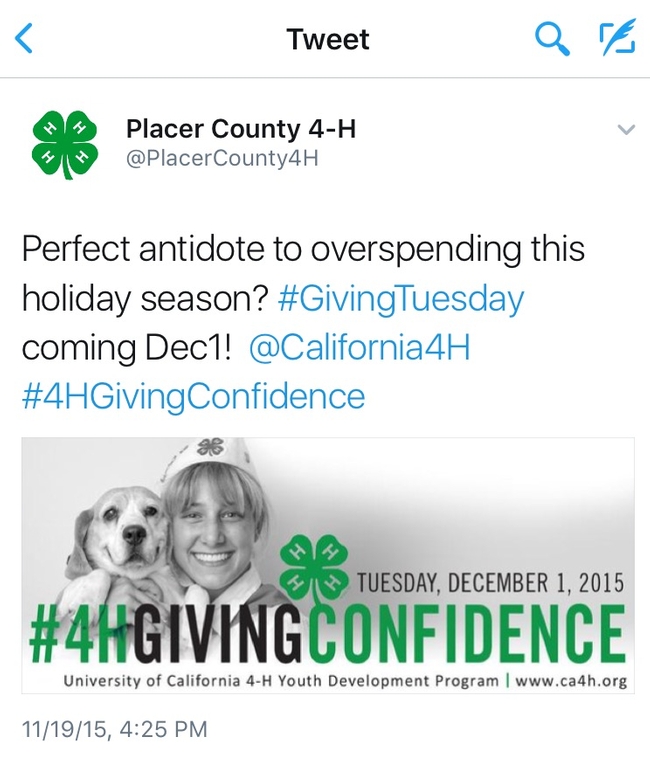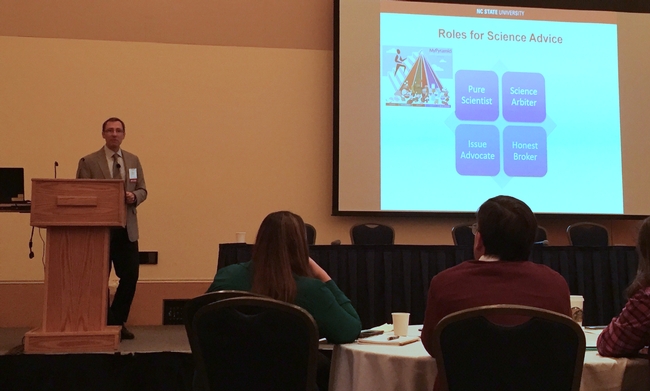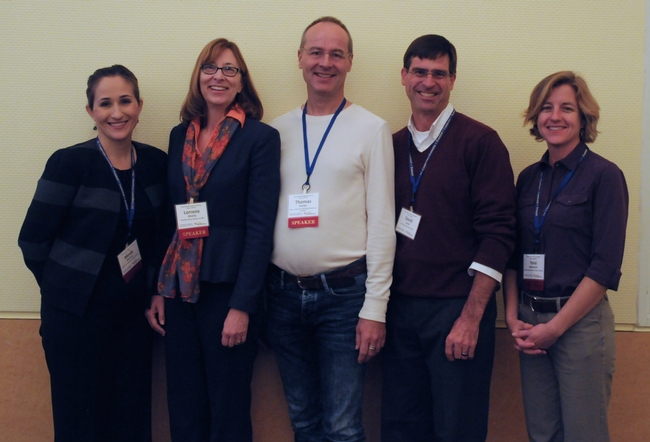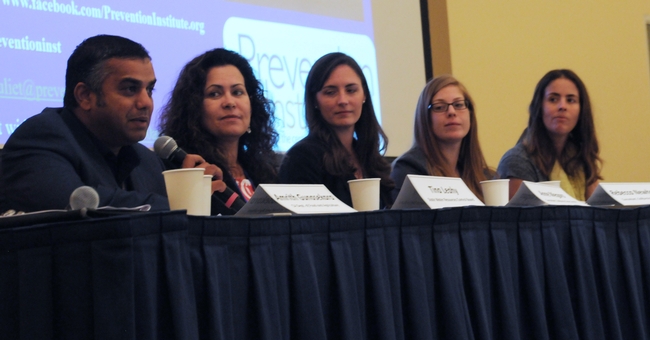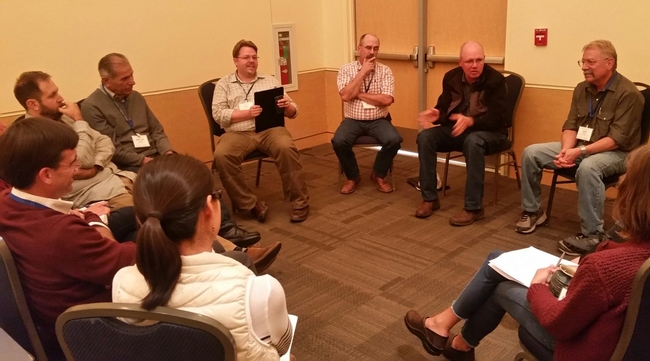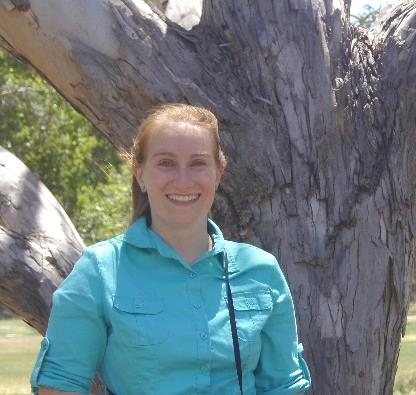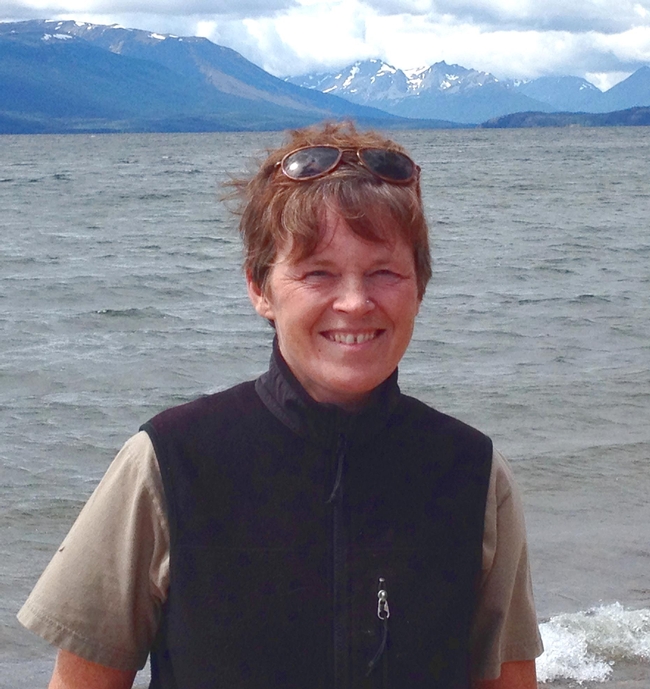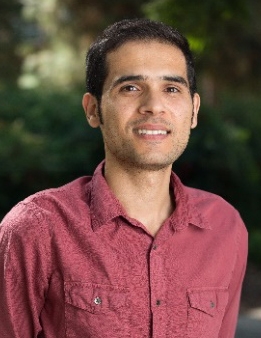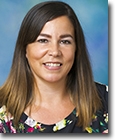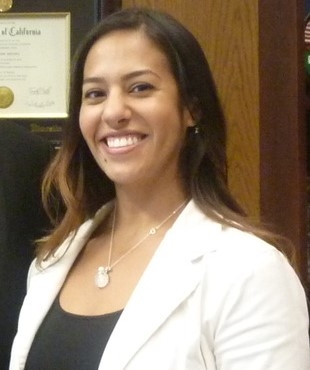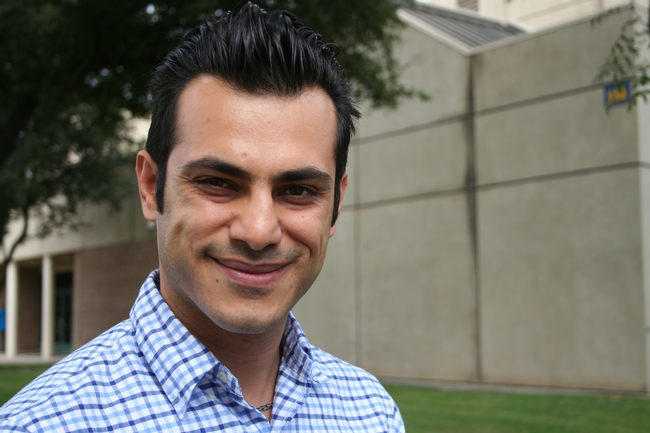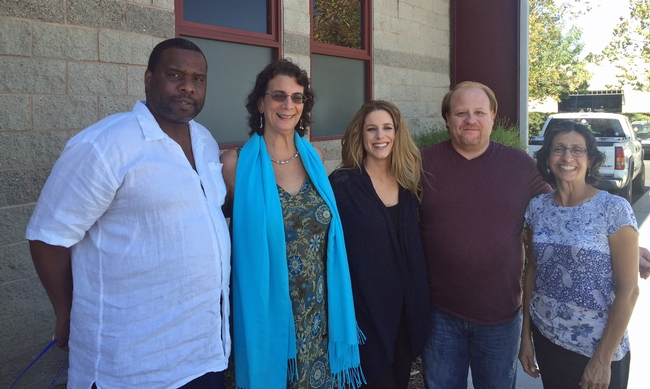Posts Tagged: SAREP
Farmers of color share their contributions, concerns in UC SAREP webinar series
When agricultural advisors came to the Cochiti Pueblo in New Mexico during the 1940s, they lined the irrigation ditches with concrete, in the name of boosting efficiency and productivity. But in single-mindedly focusing on water delivery, they neglected to consider how the previously inefficient seepage sustained nearby fruit trees.
Their actions, as well-intentioned as they might have been, disrupted the local ecosystem and killed the trees that had fed many generations, according to A-dae Romero-Briones, who identifies as Cochiti and as a member of the Kiowa Tribe.
“In my language, we call the extension agents ‘the people who kill the fruit trees,'” said Romero-Briones, director of the Food and Agriculture Program for the First Nations Development Institute, a nonprofit that serves Tribal communities across the mainland, Alaska and Hawaii.
The historically tense relationship between Indigenous peoples and government-affiliated programs is one of the many complex dynamics discussed in a six-part webinar series, “Racial Equity in Extension,” facilitated by UC Sustainable Agriculture Research and Education Program.
Making communities of color in the agricultural sector more visible is a priority for Victor Hernandez, a sociologist and outreach coordinator for the USDA's Natural Resources Conservation Service. Hernandez, who has organized “Growing Together” conferences for Latino and Black farmers, is trying to get more farmers of color to participate in the upcoming 2022 Agricultural Census.
“If we cannot quantify the demographic, we cannot justify the need,” emphasized Hernandez, explaining that his office uses the data to direct resources that advance equity in service, program delivery and distribution of funds.
A legacy of mistrust
At the same time, however, Hernandez also acknowledged the challenges in registering growers of color for the census, conducted by the USDA's National Agricultural Statistics Service. (According to Brodt, USDA's most recent agricultural census, dating to 2017, counts approximately 25,000 producers of color among 128,535 total producers in California.)
“Many of us that are considered socially disadvantaged or historically underserved…a lot of times our peoples come from [nations with] oppressive governments,” Hernandez said. “And so when you come to the United States and you begin to build your life here, to go and engage with the federal government is not the first knee-jerk reaction.”
On top of government mistrust and fears of deportation or detention, other immigrant groups have seen mainstream agriculture – borne by the “Green Revolution” wave across the globe – replace deep-rooted cultural practices, said Kristyn Leach of Namu Farm in Winters.
“It just makes these small farmers distrust our own knowledge, the knowledge that's existed for centuries – before the kind of current iteration of agriculture that we're situated within right now,” said Leach, who works to preserve the agricultural heritage of her Korean ancestors, and facilitates a farmers' collaborative called Second Generation that adapts Asian crop varieties to climate change.
According to Romero-Briones, a collective memory of supplanted culture also lingers in Indigenous communities. In the Cochiti Pueblo, “primarily a subsistence agriculture community” with a long history of corn cultivation, their practices are distinct from those in the mainstream – including regenerative and sustainable agriculture.
Building relationships takes commitment
Given that legacy of cultural displacement and appropriation, how do extension professionals and other agricultural advisors slowly rebuild trust with communities of color? For Romero-Briones, it begins with a genuine respect for Indigenous practices, and she urges interested people to contact their local tribal historic preservation officer to begin strengthening those connections and understanding – beyond a couple of phone calls.
“As someone who works with Indigenous people all day, even I need to recognize sometimes I have to meet with people up to 12 times before we actually start talking about the work that I initially wanted to talk to them about,” Romero-Briones said.
In a similar vein, Chanowk Yisrael, chief seed starter of Yisrael Family Farms, encouraged listeners to reach out to members of the California Farmer Justice Collaborative – an organization striving for a fair food system while challenging racism and centering farmers of color.
“To use a farm analogy: we've got this ground, which is the farmers of color who have been neglected for a long period of time,” said Yisrael, who has grown his farm in a historically Black neighborhood of Sacramento into a catalyst for social change. “It's not just going to be as simple as just throwing some seeds and things are going to come up; you're going to have to do more – that means you got to get out and do much more than you would do for any other community.”
Investing time in a community is one thing – and backing it up with tangible resources is another. Technical expertise is only the “tip of the iceberg,” Leach said, as historically marginalized groups are also seeking land access and tenure, more affordable cost of living, and access to capital.
“All of those things are actually much bigger burdens to bear for most communities of color than not having the knowledge of how to grow the crops that we want to grow, and not knowing how to be adaptive and nimble in the face of climate change," Leach explained, highlighting California FarmLink as an essential resource. (“Understanding Disparities in Farmland Ownership” is the next webinar in the SAREP series, set for Nov. 19.)
Bringing diverse voices to the table
Another key is ensuring that farmers and farm workers of color are represented in management and decision-making processes. Samuel Sandoval, a professor in the Department of Land, Air and Water Resources and UC Cooperative Extension specialist in water management, develops outreach programs in English and Spanish for everyone from farm workers to the “boss of the boss of the boss.”
“It has to be changed,” he said, “because at the end, the person who is going to operate the irrigation system and turn on or off the valves, the person who is looking if there's a leak or not – that's the person who's not being informed, or has not been informed on purpose.”
That exclusion of certain groups can lead to a loss of invaluable knowledge. Leach said there is a real danger in ignoring the wisdom of communities that have contributed so much to the foundation of food systems in California and around the globe.
“These really kind of amazing, sophisticated and elegant agroecological systems that we don't often legitimize through the scientific language and perspectives aren't seen as being really technically proficient – but, in many ways, they're more dynamic and more resilient than the things that we're perpetuating right now,” she said.
As a concrete example, Sandoval said that while extension advisors and specialists conduct studies to remedy a plant disease, farm workers might be developing – separately and in parallel – their own solutions by asking for advice from their social networks via WhatsApp, a phone application.
A reimagining of collaboration, Sandoval said, would include (and compensate) people working in the field for sharing their perspectives – bringing together academics and farmers, integrated pest management experts and pesticide applicators, irrigation specialists and those who do the irrigation.
A need to look within
Concerns about inclusion and validating alternate sources of knowledge apply also to the recruitment process in extension. Leach said that she has seen listings for advisor jobs that would require, at a minimum, a master's degree – which would automatically disqualify her, despite her extensive knowledge of Asian heirloom vegetables.
“When you look at a job description and you see ‘Asian crop specialist,' only required qualification is a master's degree, and then somewhere down the long list of sort of secondary desired, recommended things is some knowledge of Asian crops or communities…you know that just says a lot in terms of what has weight,” Leach explained.
Before organizations can authentically connect with communities of color, they should prioritize diversity in their own ranks, said Romero-Briones. First Nations Development Institute had to ensure that they had adequate representation across the many Tribes that they serve.
“Before we start looking out, we have to start looking in,” she explained, “and that means we have to hire Indigenous people who know these communities.”
For extension professionals and other members of the agricultural community in California, the UC SAREP webinar series has helped spark that introspection and a meaningful reevaluation of institutional processes and assumptions.
“These discussions have been tremendously illuminating and eye-opening,” Brodt said. “But hearing and learning is just the start – it's incumbent on us, as an organization and as individuals, to take action to ensure that farmers of color and their foodways are truly respected and valued.”
SAREP offers small grants
The 2022/23 SAREP Sustainable Agriculture & Food Systems Small Grants Program is accepting applications until 12 noon PST, Feb. 15, 2022.
SAREP invites proposals for small grants to fund pilot projects and research projects that support California's farmers, ranchers and land stewards and/or rural, urban, and Tribal communities to plan, implement or evaluate sustainable agriculture or food systems strategies.
Program Priority Areas
UC SAREP will fund projects that fall within two priority areas:
1. Support California's farmers, ranchers and land stewards of all scales in identifying, piloting and transitioning to
- environmentally regenerative approaches to producing crops and livestock (including but not limited to soil health, organic and agroecological practices, integrated pest management, crop diversification);
- pathways for realizing economic return from ecologically-sound crop management practices and fair labor practices;
- marketing and distribution strategies that support diversified, decentralized, and locally self-organized supply chains;
- strategies that promote producer-to-producer networking and producer-to-supply chain networking
2. Support California's rural, urban, and Tribal communities to identify, implement and evaluate strategies to
- expand access to healthy, sustainably produced, culturally appropriate foods;
- ensure worker well-being across the food chain;
- minimize the community and environmental costs of food production and distribution;
- strengthen connections between consumers and producers;
- establish and strengthen producer-to-producer connections and producer-to-supply chain connections
Priority will be given to projects that benefit socially disadvantaged communities and/or socially disadvantaged farmers and ranchers. We strongly encourage projects that are led by individuals and/or community-based organizations from these groups.
We are interested in projects that build the capacity of farming and food systems businesses and organizations to become reflective, adaptive learning organizations that can respond effectively to ecological, economic, and social change and disruption.
Proposal categories
Proposals are requested for three types of projects:
- Planning Grants
- Education and Outreach Grants
- Applied Research Grants
Information about each category and examples of previously funded projects, can be found at https://sarep.ucdavis.edu/grantsFY21-22.
Who can apply
Eligible applicants include farm or food system businesses operating in California, nonprofit, tax-exempt organizations operating in California, state and local government agencies, tribal governments, and California public and private institutions of higher education.
Applicants must demonstrate meaningful collaboration and involvement of stakeholders in the design and execution of the project. Priority is also given to projects that foster cross-collaborations between multiple types of applicants, contributing to a unified approach in addressing core areas of concern.
For more information and requirements, please visit the SAREP Sustainable Agriculture and Food Systems Small Grants Program webpage or contact Rachael Callahan at rmcallahan@ucanr.edu.
ANR reaches out to donors on #GivingTuesday
Last year, the 4-H Youth Development Program and UC Master Gardener Program successfully participated in #GivingTuesday campaigns.
“Our goal for 4-H was to raise $10,000 and we exceeded our goal with donations totaling over $13,000,” said Andrea Ambrose, acting director of Development Services. 4-H programs in 17 counties participated. In Placer County, the robotics team got their friends and family involved to promote #4HGivingConfidence on social media, leading Placer County to collect the largest amount for the 4-H Youth Development Program.
Although not as widely recognized as the shopping events Black Friday and Cyber Monday, #GivingTuesday appeals to people swept up in the spirit of giving at the end of the year.
“#GivingTuesday is a wonderful opportunity for all ANR programs to augment their funding with private donations,” said Ambrose.
A website is being created with links to all of ANR's programs, Research and Extension Centers and extension offices. Donors will be invited to designate the program or location to which they wish to donate. The URL for the #GivingTuesday website will be announced in ANR Update soon.
ANR will provide a toolkit for county offices and programs to participate. It will include:
- A customizable letter to send to stakeholders
- Templates for “unselfies.” Donors may take photos of themselves holding an unselfie sign and share on social media how they are giving.
- Sample tweets and social media posts
- Sample thank you note
UC Research to Policy Conference puts science into action
“We focused on fostering a good dialogue and facilitating co-learning among attendees,” said event co-chair Leslie Roche, assistant UC Cooperative Extension specialist in rangeland management. “We hosted university faculty, statewide CE specialists and academics, and county-based CE advisors—as well as local policymakers and leaders from non-governmental organizations and statewide programs.”
UC researchers who have successfully engaged in the public policy arena provided numerous models of linking research and policy. There were five key take-aways for scientists:
- Honest broker role – Present policymakers with various policy options, based on sound research. Have a clear understanding of the science behind your messaging. Use qualitative data to tell the story of the hard quantitative data.
- Active engagement – Be part of informational and oversight hearings. Empower communities to take action and foster community engagement.
- Build coalitions – Collaboration is imperative. Develop unexpected allies and foster long-term relationships, realizing it may take some time to bear fruit.
- Disseminate information – Share your data in user-friendly formats. Target local community, Legislature and state agencies to inform policies. Get your science into trainings and continuing education programs. Leverage your coalition to expand the circulation of your research results.
- Target messages – Develop a strong, concise message to deliver your research. Use an emotional connection – “Old-growth oak woodlands” versus “oak woodland.”
Throughout the conference, speakers highlighted the multiple levels of engagement for researchers in the policy arena, with different roles matching different needs – some take a center stage, while others play imperative behind-the-scenes roles.
Keynote speaker Jason Delborne, associate professor of science, policy and society at North Carolina State University, encouraged engaging the public. “Science is a social process,” he said, noting that community and public engagement is often key to successfully applying research to policy. Delborne also touched on the tension between expertise and democracy, commenting that we can't always resolve it and often we have to learn to live with this tension.
A diverse set of researchers shared their perspectives from experiences in engaging in policy. The panel included Thomas Harter, Robert M. Hagan Endowed Chair in Water Management and Policy and UCCE specialist in the Department of Land, Air, and Water Resources at UC Davis; Lorrene Ritchie, director of the UC ANR Nutrition Policy Institute; Mindy Romero, founder and director of California Civic Engagement Project at UC Davis Center for Regional Change; and Yana Valachovic, UCCE forest advisor and county director in Humboldt and Del Norte counties. They discussed the importance of building strong science-based programs, actively engaging local communities and building coalitions of support.
Guests from both government and non-government organizations who use research to shape policy shared their perspectives on translating science to decision-making.
“Science is the foundation for developing programs,” said Amrith Gunasekara, science advisor for the California Department of Food and Agriculture.
Tina Cannon Leahy, attorney with the State Water Resources Control Board, noted that policymakers and decision-makers are often looking for a clear, “black-and-white” answer, while for scientists, there is “no answer,” but rather information.
Anne Megaro, consultant to the California Senate Committee on Agriculture, and Rebecca Newhouse, consultant to the California Senate Environmental Quality Committee, both emphasized the importance of making sure science is accessible and digestible.
Juliet Sims of the Prevention Institute explained how her organization uses both published scholarly literature and community stories to effectively inform its advocacy platform.
Keynote speaker Rachel Morello-Frosch, associate professor in the Department of Environmental Science, Policy and Management at UC Berkeley, introduced the concept of moving from “translational research” to “transformational research,” a shift that requires deep community engagement in meaningful ways to effect policy change.
In the afternoon, four breakout sessions were offered: “Policy structures and opportunities for engagement” with Robert Waste, “Relational approaches to science communication and engagement” with Faith Kearns, “Putting it into practice–UC ANR case studies” with Dave Campbell, Clare Gupta and Lucas Frerichs, and “Navigating policy engagement: Education vs advocacy,” with Adrian Lopez and Kit Batten. These training modules helped participants build technical skills and analytical frameworks for successful policy engagement.
The Research to Policy Conference was a forum to exchange ideas and share perspectives, continuing to bridge the gap between science and policy communities. It challenged attendees to be open to new ways of thinking, shared innovative outreach methods and showcased how research can have an impact in the policy arena.
“The event brought cross-fertilization and co-learning between disciplines – nutrition, forest management, water quality – and there were common themes that resonated for all participants,” said event co-chair Gupta, assistant UCCE specialist in public policy and translational research.
VP Glenda Humiston wrapped up the policy conference by saying, "Good science is vital for good policy. It's great to see UC folks enhancing these skills to bring science together with policy."
For more information on applying research to policy, contact Frerichs, UC ANR government and community relations manager, at (530) 750-1218 or lfrerichs@ucanr.edu, or Research to Policy Program Team contacts Gupta at cgupta@ucdavis.edu and Roche at lmroche@ucdavis.edu.
Names in the News
Ozeran named UCCE livestock and natural resources advisor
Rebecca Ozeran joined UCCE on Sept. 12 as the area livestock and natural resources advisor in Fresno and Madera counties.
Raised in Yuba City with a passion for animals and the land that supports them, Ozeran plans to focus her research, outreach and extension education efforts on current issues impacting livestock producers and land managers in both counties.
Prior to joining UCCE, Ozeran was a range management intern for the Bureau of Land Management in the Salt Lake City field office. Her duties included collecting inventory, utilization and rangeland trend data, checking livestock compliance on BLM allotments and collaborating with local archaeologists to ensure compliance with archaeology requirements before grazing permit renewal. From July 2014 to May 2016, Ozeran was a graduate research and teaching assistant for the Department of Animal and Range Sciences at Montana State University.
She earned a B.S. in animal science with a minor in Spanish from Cal Poly, and an M.S. in animal and range sciences with a certificate in applied statistics from Montana State University. Her thesis studied patterns and risk factors of cheatgrass invasion in Montana foothills rangelands.
Ozeran is based in Fresno and be reached at (530) 415-2555 and rkozeran@ucanr.edu.
Axelson joins UCCE as forest health specialist
Jodi Axelson joined UCCE on June 1 as a UC Cooperative Extension specialist in forest health in the Department of Environmental Science, Policy and Management (ESPM) at UC Berkeley.
Axelson's broad research interests include forest resilience, adaptive management and forest disturbance; specifically, she is focused on forest dynamics and response to insect disturbances from outbreaks of bark beetles and conifer defoliators using a range of methods including dendrochronology. Learn more about her research at http://ourenvironment.berkeley.edu.
Prior to joining UCCE, Axelson was employed by the British Columbia government as a forest entomologist with Ministry of Forests, Lands and Natural Resource Operations. In this position, she was responsible for forest health issues in an area covering 42,000 square miles comprised of distinct wet- and dry-belt ecosystems. She gained considerable experience in taking into consideration timber, wildlife and land stewardship objectives when performing insect monitoring, treatment and risk-mitigation.
She earned her B.S. in geography from the University of Victoria (British Columbia, Canada), an M.S. in geography from the University of Regina (Saskatchewan, Canada) and a Ph.D. in geography from the University of Victoria.
Axelson is based at the UC Berkeley campus and can be reached at (510) 642-8459 and jodi.axelson@berkeley.edu. Follow her on Twitter @DisturbedDendro.
Haghverdi joins UCCE as urban water specialist
Amir Haghverdi joined UCCE on July 1 as a UC Cooperative Extension specialist in the Department of Environmental Sciences at UC Riverside. His research focuses on integrated urban water management.
Prior to joining UCCE, Haghverdi had been an assistant professor in the Department of Biological Systems Engineering at University of Nebraska-Lincoln, performing research and extension on irrigation and water management, since July 2015.
Haghverdi earned his B.S. in irrigation engineering from University of Tehran, Iran, an M.S. in agricultural engineering - irrigation and drainage from Bu-Ali Sina University, Iran, a Ph.D. in irrigation and drainage engineering from Ferdowsi University of Mashhad, Iran, and a Ph.D. in biosystems engineering from University of Tennessee-Knoxville.
Haghverdi can be reached at (951) 827-4774 and amir.haghverdi@ucr.edu.
Saitone named ag economics specialist
Tina Saitone joined UCCE on June 1 as a UC Cooperative Extension specialist in the Department of Agricultural and Resource Economics (ARE) at UC Davis, where she is focused on livestock and rangeland economics. Saitone conducts research on a broad range of topics in agricultural economics including food quality and safety, agricultural cooperatives, industry competition, generic commodity promotion, and federal and state marketing orders.
Prior to joining UCCE, Saitone had been a project scientist for ARE since July 2015. Before returning to UC Davis, she worked for OnPoint Analytics, an economic consulting firm in the Bay Area, where she conducted research on a wide variety of agricultural industries including meatpacking, dairy, eggs, broilers and sugar beets.
Saitone earned her B.A. in economics at Sonoma State University and her M.S. and Ph.D. in agricultural and resource economics at UC Davis.
Saitone can be reached at (530) 752-1870 and saitone@primal.ucdavis.edu.
Bautista named 4-H STEM coordinator
Jessica Bautista joined ANR on July 5 as the 4-H Science, Technology, Engineering & Mathematics (STEM) academic coordinator.
Prior to joining ANR, Bautista was a graduate research assistant in the Department of Botany and Plant Sciences at UC Riverside. Bautista's area of research interest focused on molecular biology and genetics in plant developmental biology.
As a native Californian and a first-generation student born to Mexican migrant parents, Bautista speaks Spanish and has fostered various methods to make her research accessible and advocate for STEM career paths for underrepresented communities. In 2012, Bautista co-founded UCR's Plant Discovery Day in the Department of Botany and Plant Sciences. This annual outreach event is filled with interactive science demonstrations for elementary school students in the community. She has also presented her research and discussed her career path annually since 2013 at workshops geared towards teaching and empowering young Latina women to pursue higher education and various career options.
Bautista completed a B.S. in biotechnology (chemistry minor) from California State University Northridge and a Ph.D. in plant biology from UC Riverside.
Bautista is based at the ANR building in Davis and can be reached at (530) 750-1341 and jbautista@ucanr.edu.
Pourreza wins international prize for HLB detection
Newly appointed UC Cooperative Extension agricultural engineering advisor Alireza Pourreza has been awarded the 2016 Giuseppe Pellizzi Prize by the Club of Bologna, an honor presented every other year to the best doctoral dissertations focused on agricultural machinery and mechanization. The Club of Bologna is a world taskforce on strategies for the development of agricultural mechanization.
Pourreza, who earned his Ph.D. at the University of Florida in 2014, worked on early detection of Huanglongbing disease of citrus. Huanglongbing, an incurable disease that is spread by Asian citrus psyllid, has seriously impacted citrus production in Florida. The disease has been found in commercial and residential sites in all counties with commercial citrus.
Early detection allows growers to remove infected trees before the disease can spread to healthy trees. Currently HLB infection is confirmed when leaves with yellowing blotches are submitted for PCR testing, which is expensive and time-consuming. However, the yellowing can be also symptomatic of other conditions, such as nutrient deficiency.
"We discovered we could see the symptoms of Huanglongbing using a camera, a set of cross-polarizers and narrowband lighting before it is visible to the human eye," said Pourreza, who is based at the UC Kearney Agricultural Research and Extension Center in Parlier.
He said the yellow blotches on HLB-infected leaves are caused by starch accumulation.
"If we could detect abnormal levels of starch in the leaf, we could tell it is affected with HLB," Pourreza said. "Starch showed the ability to rotate the polarization plane of light. We used this optical characteristic to develop the sensing methodology."
Pourreza said the team has patented the technique and is working on developing a commercial product. He is seeking funding to continue the research in California, where, to date, HLB has only been detected in isolated Los Angeles neighborhoods. Asian citrus psyllid is found in important California commercial citrus production regions from the Mexican border to as far north as Placer County.
4-H Youth Development team wins national diversity award
4-H Youth Development advisors Dorina Espinoza, Russell Hill, Fe Moncloa and Keith Nathaniel and 4-H associate director Shannon Horrillo have won the National Extension Diversity Award for systematically enhancing the intercultural competency of 4-H personnel and others in California.
The award, given by USDA National Institute of Food and Agriculture (NIFA), Cooperative Extension System and the Association of Public and Land-grant Universities (APLU), honors the team for creating and using Intercultural Development Inventory© to shift organizational culture. This shift includes mutual respect, acceptance, teamwork and productivity among diverse people.
To meet the needs of a culturally and ethnically diverse youth population in California, they created a professional-development intervention for 4-H academics and staff. The Intercultural Development Inventory© is a cross-culturally generalizable, valid and reliable assessment of intercultural competence. Calling themselves the Intercultural Development Inventory Qualified Administrators, they applied the strategy over three years, providing 176 hours of intercultural communication feedback sessions, learning communities and regional conferences to enhance the intercultural competence of 65 4-H personnel.
Evaluations demonstrated that after the intervention UC 4-H Youth Development Program personnel had acquired skills and characteristics to become more culturally competent. The program has moved from focusing on similarities across diverse people that can mask deeper recognition of cultural differences to recognizing the complexity of dimensions of diversity.
The action plan and resulting positive change provides the potential to improve hiring and professional development nationwide by replication in other states. A summary of California's IDI professional development activities can be found in the National 4-H Latino Youth Outreach: Best Practices Toolkit, Professional Development.
The National Extension Diversity Award will be presented on Nov. 13 at the 129th APLU Annual Meeting in Austin, Texas.

